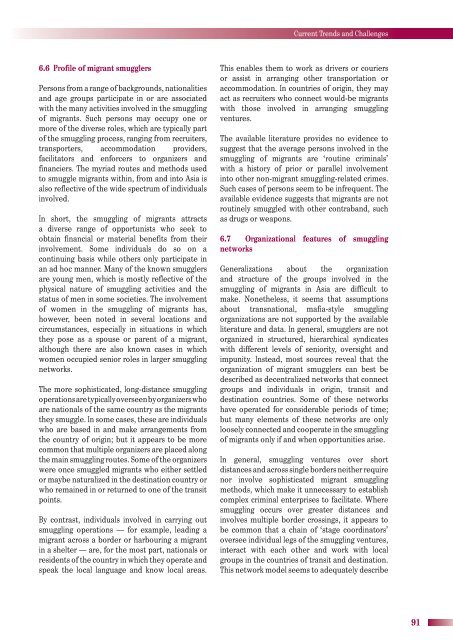Current_Trends_and_Related_Challenges_web
Current_Trends_and_Related_Challenges_web
Current_Trends_and_Related_Challenges_web
You also want an ePaper? Increase the reach of your titles
YUMPU automatically turns print PDFs into web optimized ePapers that Google loves.
<strong>Current</strong> <strong>Trends</strong> <strong>and</strong> <strong>Challenges</strong><br />
6.6 Profile of migrant smugglers<br />
Persons from a range of backgrounds, nationalities<br />
<strong>and</strong> age groups participate in or are associated<br />
with the many activities involved in the smuggling<br />
of migrants. Such persons may occupy one or<br />
more of the diverse roles, which are typically part<br />
of the smuggling process, ranging from recruiters,<br />
transporters, accommodation providers,<br />
facilitators <strong>and</strong> enforcers to organizers <strong>and</strong><br />
financiers. The myriad routes <strong>and</strong> methods used<br />
to smuggle migrants within, from <strong>and</strong> into Asia is<br />
also reflective of the wide spectrum of individuals<br />
involved.<br />
In short, the smuggling of migrants attracts<br />
a diverse range of opportunists who seek to<br />
obtain financial or material benefits from their<br />
involvement. Some individuals do so on a<br />
continuing basis while others only participate in<br />
an ad hoc manner. Many of the known smugglers<br />
are young men, which is mostly reflective of the<br />
physical nature of smuggling activities <strong>and</strong> the<br />
status of men in some societies. The involvement<br />
of women in the smuggling of migrants has,<br />
however, been noted in several locations <strong>and</strong><br />
circumstances, especially in situations in which<br />
they pose as a spouse or parent of a migrant,<br />
although there are also known cases in which<br />
women occupied senior roles in larger smuggling<br />
networks.<br />
The more sophisticated, long-distance smuggling<br />
operations are typically overseen by organizers who<br />
are nationals of the same country as the migrants<br />
they smuggle. In some cases, these are individuals<br />
who are based in <strong>and</strong> make arrangements from<br />
the country of origin; but it appears to be more<br />
common that multiple organizers are placed along<br />
the main smuggling routes. Some of the organizers<br />
were once smuggled migrants who either settled<br />
or maybe naturalized in the destination country or<br />
who remained in or returned to one of the transit<br />
points.<br />
By contrast, individuals involved in carrying out<br />
smuggling operations — for example, leading a<br />
migrant across a border or harbouring a migrant<br />
in a shelter — are, for the most part, nationals or<br />
residents of the country in which they operate <strong>and</strong><br />
speak the local language <strong>and</strong> know local areas.<br />
This enables them to work as drivers or couriers<br />
or assist in arranging other transportation or<br />
accommodation. In countries of origin, they may<br />
act as recruiters who connect would-be migrants<br />
with those involved in arranging smuggling<br />
ventures.<br />
The available literature provides no evidence to<br />
suggest that the average persons involved in the<br />
smuggling of migrants are ‘routine criminals’<br />
with a history of prior or parallel involvement<br />
into other non-migrant smuggling-related crimes.<br />
Such cases of persons seem to be infrequent. The<br />
available evidence suggests that migrants are not<br />
routinely smuggled with other contrab<strong>and</strong>, such<br />
as drugs or weapons.<br />
6.7 Organizational features of smuggling<br />
networks<br />
Generalizations about the organization<br />
<strong>and</strong> structure of the groups involved in the<br />
smuggling of migrants in Asia are difficult to<br />
make. Nonetheless, it seems that assumptions<br />
about transnational, mafia-style smuggling<br />
organizations are not supported by the available<br />
literature <strong>and</strong> data. In general, smugglers are not<br />
organized in structured, hierarchical syndicates<br />
with different levels of seniority, oversight <strong>and</strong><br />
impunity. Instead, most sources reveal that the<br />
organization of migrant smugglers can best be<br />
described as decentralized networks that connect<br />
groups <strong>and</strong> individuals in origin, transit <strong>and</strong><br />
destination countries. Some of these networks<br />
have operated for considerable periods of time;<br />
but many elements of these networks are only<br />
loosely connected <strong>and</strong> cooperate in the smuggling<br />
of migrants only if <strong>and</strong> when opportunities arise.<br />
In general, smuggling ventures over short<br />
distances <strong>and</strong> across single borders neither require<br />
nor involve sophisticated migrant smuggling<br />
methods, which make it unnecessary to establish<br />
complex criminal enterprises to facilitate. Where<br />
smuggling occurs over greater distances <strong>and</strong><br />
involves multiple border crossings, it appears to<br />
be common that a chain of ‘stage coordinators’<br />
oversee individual legs of the smuggling ventures,<br />
interact with each other <strong>and</strong> work with local<br />
groups in the countries of transit <strong>and</strong> destination.<br />
This network model seems to adequately describe<br />
91


